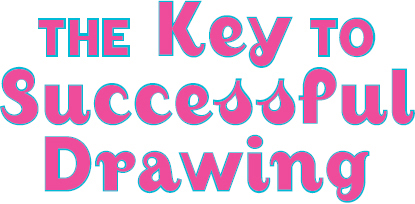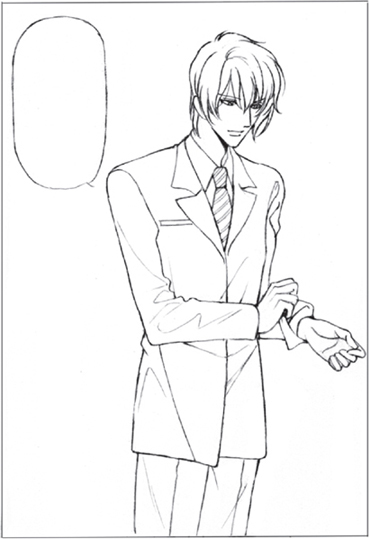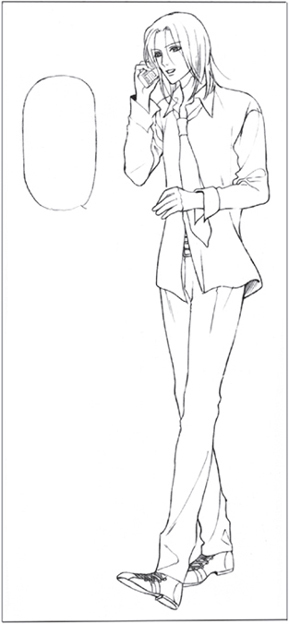

OFTEN, BEGINNERS TRY VERY HARD to get the faces and bodies right, yet their poses still end up being uninteresting. What went wrong? The invaluable drawing secret that most beginners have never even heard about—that will transform beginner work into advanced drawing without much effort—is secondary action.
When a character performs a primary action (such as standing, talking, or walking), which frequently isn’t interesting in its own right, the solution lies in giving the character a secondary action—something minor to do—simultaneously. When you do this, characters are more interesting to watch. Maybe she’s walking but also talking on a cell phone. Maybe he’s sitting but at the same time writing a note to himself—in other words, doing something active. Believe me, these minor tweaks make a tremendous difference in the energy and vitality of a pose. And they’re easy fixes, techniques you can start using right away. Examine the examples in this chapter, and see for yourself. I want you to decide which is more interesting to look at. Ready?
Characters standing around doing a lot of nothing are every artist’s great nemesis. You’ve got to fight these soporific scene destroyers by sprucing up your staging with a little bit of secondary action, as shown.

PRIMARY ACTION: STANDING (WHILE TALKING)
Standing and talking (which doesn’t count as a secondary action) is the most common pose in manga graphic novels. But it becomes boring having characters just stand there next to speech balloons with their mouths open. A hand gesture, like this one, helps a little, but the energy level is still low. Low energy is okay if a character’s doing the listening. But this character is a teenager who’s doing the talking. How many teenage girls do you know who are low energy?

SECONDARY ACTION: RUMMAGING THROUGH PURSE
Adding a secondary action provides a quick and simple solution. All she has to do while speaking is to dig into her purse, and suddenly, she’s actively engaged in doing something, rather than standing still. Her posture loses its stiffness, and the prop, her purse, is also brought into the act.
PRIMARY ACTION: STANDING (WHILE TALKING)
Whoa! Talk about stiff! This drawing is crying out for a secondary action. Looks like he’s standing at attention or rigor mortis has set in—I’m not sure which. Yet this is a very common pose among beginners.

SECONDARY ACTION: ADJUSTING HIS CLOTHES
A quick, little adjustment of his cuff (whether or not it really needs it) is all it takes. See how much more relaxed he looks as he bends both of his arms? He looks at his sleeve, so he’s not continuously looking straight ahead at the person he’s talking to panel after panel. This breaks up the rhythm and therefore is a pleasing technique to use in storytelling for graphic novels.
Walking is a more difficult pose to draw than people realize. The arms move in front and behind the torso, with fingers spread, holding nothing. It’s hard to make that look natural. And once you’ve got it, it’s not all that interesting, either!

PRIMARY ACTION: WALKING
This guy is walking without purpose, it seems. What can you do to make it look more engaging? What about giving him a secondary action, something that gives him another thing to do with his hands while he’s walking?

SECONDARY ACTION: WALKING THE DOG
By giving the teen a dog, you not only give him something to do, but you suggest a story. There’s suddenly the possibility that he’ll meet someone with his dog, maybe a girl and her dog, in a park setting. This dog owner looks at his dog, so there’s a relationship there; he’s not just staring straight ahead into space, as he was doing when he was walking without purpose.
PRIMARY ACTION: WALKING CASUALLY
This character may be out for a stroll, but frankly, his pose is putting me to sleep! The problem with this drawing is typical not only for beginning artists but even for some pros: The drawing itself is excellently rendered but static. The hands are down by the sides, doing nothing. Why not make use of them to liven up the scene?

SECONDARY ACTION: TALKING ON A CELL
Something as basic as talking on a cell phone animates a character significantly. We now imagine that he’s on his way to meet whomever he is speaking to on the phone (his girlfriend, perhaps). The walk takes on more urgency not because the gait is drawn differently, which it’s not, but because he’s speaking in an engaged manner. We want to know what’s being said, and this draws us into the scene, unlike the previous image.
Sitting is an inactive pose by definition, so it’s not wrong for a character to sit without a secondary action. It works, but it’s subdued. However, if you want to show a perky character, one with a bubbly personality, you need to give her a secondary action.

PRIMARY ACTION: SITTING
This character is very closed up, with her knees together and hands on her knees. There’s a lot of tension in the pose.

SECONDARY ACTION: TEXTING
People text while they do everything—talking, shopping, eating. In this way, you quickly define your character as a typical high-voltage teenager with a type A personality, which is an appealing character to watch and quite different than the previous, restrained type.
PRIMARY ACTION: SITTING AT A DESK
Sitting stiffly at a desk, back straight, listening attentively to a lecture in class may be what a teacher wants you to do, but it’s not the best look for a manga character. Not relaxed enough. Not active enough. Not interesting enough.

SECONDARY ACTION: TAKING NOTES
Now he’s hunched over his paper, taking notes furiously as his teacher (who’s off-panel) gives her talk. Note that his back leans forward off the chair. This is a much more engaging scene. Now we feel the pressure and know we’re in a classroom!
PRIMARY ACTION: SITTING (WHILE TALKING)
This is a good pose as it is. She’s pretty, with an open face and appealing looks. She gestures nicely with her hand. And yet, if you want to do your very best work, you always have to ask yourself that one nagging question: Can I do more with it? In this case, the pose could be a little more fun, don’t you agree? It sort of sits there, like plain vanilla. It functions but doesn’t inspire. And we want to inspire the reader. So let’s compare it to the next example.

SECONDARY ACTION: TYING HER SHOE
What does it mean that she’s tying her shoe? It means that she’s getting ready to go. She’s an on-the-go gal, active, whereas before she appeared inactive. And that wink at the reader also helps, adding a touch of flirty humor. Other similar actions could be zipping up a vest, putting on her boots (easier to draw than tying laces), tying a hood into place, or putting on mittens.
Sitting on the knees is a feminine pose, which shows passivity. Here’s an example of a situation where we may not want to add a secondary action because it may make the character appear too lively. After all, she’s sweet and quiet, and meant to be that way. Still…

PRIMARY ACTION: KNEELING (WHILE TALKING)
If you can find a secondary action that will reinforce a kneeling character’s femininity, as well as give her something to do with her hands, then it will be a positive addition to what is otherwise a static scene.

SECONDARY ACTION: BRUSHING HAIR
The lesson here is that no matter how routine the secondary action is, whether it’s brushing hair or putting away clothes, doing something is more interesting than doing nothing.